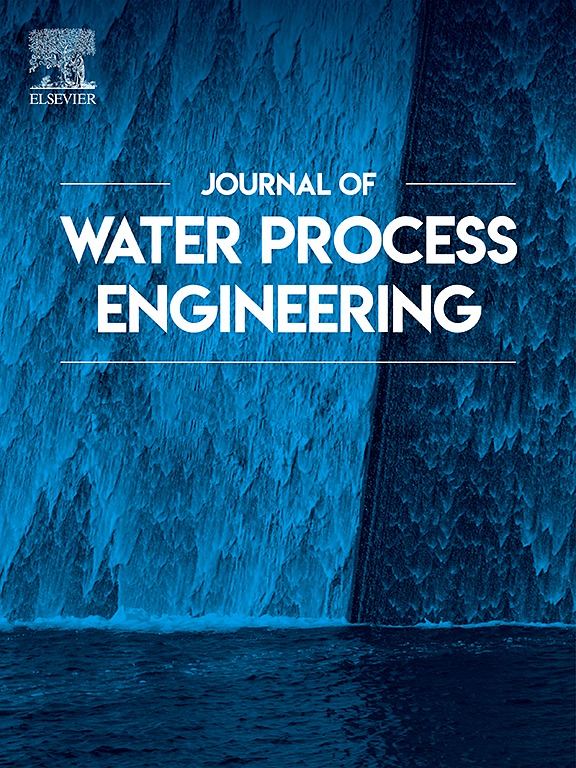Feasibility of phytoremediation/pyrolysis/adsorption framework for valorization of water hyacinth: Life cycle assessment, techno-economics, and sustainability pillars
IF 6.3
2区 工程技术
Q1 ENGINEERING, CHEMICAL
引用次数: 0
Abstract
While several studies have employed phytoremediation to treat surfactant-laden kitchen wastewater (SLKWW), there exists a research gap in addressing the profitability, sustainability, and environmental effects related to spent plant valorization. This work utilizes water hyacinth for SLKWW phytoremediation, followed by managing the exhausted aquatic macrophyte by either direct disposal into landfills (Scenario#1), or pyrolysis to generate biochar used as an adsorbent for post-treatment (Scenario#2). The best scenario was selected based on the techno-financial study, life cycle analysis (LCA) impact categories, and sustainable development goals (SDGs) achieved. The phytotechnology was operated under 23 ± 2 °C, light:dark cycle of 18:6 h:h, 65 ± 5 % relative humidity, plant density (1.0–4.0 kg m−2), pH (3–11), and retention time (4–14 d), getting maximum surfactant removal efficiency = 97.45 ± 4.62 %. The exhausted plant biomass was pyrolyzed at 500 °C for 120 min to produce biochar used as an adsorbent for effluent treatment, achieving 91.39 ± 4.43 % surfactant removal at adsorbent dosage = 8.9 g L−1, pH = 4.3, and time = 135 min. The techno-economic investigation demonstrated that Scenario#2 was the desired pathway with enhanced financial performance (net present value = 12.5 US$, internal rate of return = 8.2 %, and payback period = 7.1 years), and superior LCA environmental benefits related to human health and carbon credit. The study outcomes comply with SDG_3 “protect human health from landfill leachate”, SDG_6 “surfactant-laden kitchen wastewater treatment”, SDG_7 “exhausted plant pyrolysis”, and SDG_12 “recycling of plant residues”. Further studies should focus on the sustainable management of the exhausted adsorbent after SLKWW post-treatment to avoid the risk of secondary pollution.

求助全文
约1分钟内获得全文
求助全文
来源期刊

Journal of water process engineering
Biochemistry, Genetics and Molecular Biology-Biotechnology
CiteScore
10.70
自引率
8.60%
发文量
846
审稿时长
24 days
期刊介绍:
The Journal of Water Process Engineering aims to publish refereed, high-quality research papers with significant novelty and impact in all areas of the engineering of water and wastewater processing . Papers on advanced and novel treatment processes and technologies are particularly welcome. The Journal considers papers in areas such as nanotechnology and biotechnology applications in water, novel oxidation and separation processes, membrane processes (except those for desalination) , catalytic processes for the removal of water contaminants, sustainable processes, water reuse and recycling, water use and wastewater minimization, integrated/hybrid technology, process modeling of water treatment and novel treatment processes. Submissions on the subject of adsorbents, including standard measurements of adsorption kinetics and equilibrium will only be considered if there is a genuine case for novelty and contribution, for example highly novel, sustainable adsorbents and their use: papers on activated carbon-type materials derived from natural matter, or surfactant-modified clays and related minerals, would not fulfil this criterion. The Journal particularly welcomes contributions involving environmentally, economically and socially sustainable technology for water treatment, including those which are energy-efficient, with minimal or no chemical consumption, and capable of water recycling and reuse that minimizes the direct disposal of wastewater to the aquatic environment. Papers that describe novel ideas for solving issues related to water quality and availability are also welcome, as are those that show the transfer of techniques from other disciplines. The Journal will consider papers dealing with processes for various water matrices including drinking water (except desalination), domestic, urban and industrial wastewaters, in addition to their residues. It is expected that the journal will be of particular relevance to chemical and process engineers working in the field. The Journal welcomes Full Text papers, Short Communications, State-of-the-Art Reviews and Letters to Editors and Case Studies
 求助内容:
求助内容: 应助结果提醒方式:
应助结果提醒方式:


